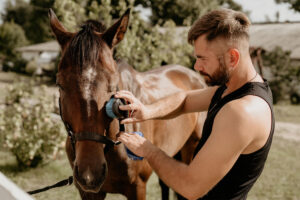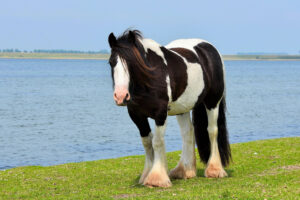
Horses possess a remarkable array of unique facial and leg markings that add to their individuality and beauty. Whether you’re a seasoned horse enthusiast or a novice admirer, understanding these markings can deepen your appreciation for these majestic creatures. In this article, we present a comprehensive chart of equine face and leg markings, highlighting their characteristics and providing valuable insights into their significance.
- Blaze: Blazes are prominent white markings that extend down the center of a horse’s face, usually from the forehead to the muzzle. They can vary in width, from a narrow stripe to a broad blaze that covers most of the face. Blazes often enhance a horse’s facial features, adding elegance and distinction to their appearance.
- Stripe: Similar to a blaze, a stripe is a vertical white marking that runs down the center of a horse’s face. However, unlike a blaze, a stripe is usually narrower and extends only from the forehead to the bridge of the nose. It can be a subtle or pronounced feature, contributing to the overall charm of the horse.
- Star: A star is a small, symmetrical white marking located on the horse’s forehead. It is often a circular or diamond shape and can vary in size. Stars give horses a unique touch and are regarded as a mark of individuality and beauty.
- Snip: A snip is a small white marking found on the horse’s muzzle, between the nostrils. It can be a thin line or a broader patch, adding a charming detail to the horse’s facial profile. Snips are often considered adorable and can vary greatly in shape and size.
- White Face: A white face refers to a horse with extensive white markings that cover a significant portion of the face. These markings can range from a wide blaze and an extended stripe to additional patches of white on the sides of the face. Horses with white faces possess a captivating allure that distinguishes them from others.
Leg Markings:
- Coronet: Coronets are the smallest white markings found just above the hoof, encircling the horse’s pastern area. They appear as a thin band of white and can be present on one or more legs. Coronets often accentuate the horse’s lower limbs, adding a touch of elegance and charm.
- Pastern: Pastern markings extend higher than coronets and usually cover a larger area of the horse’s pastern region. These markings can be on the front, back, or both sides of the pasterns. The size and shape of pastern markings vary, contributing to the horse’s overall appearance.
- Fetlock: The fetlock, a crucial joint in a horse’s leg, is a key component of their overall anatomy and movement. Understanding the fetlock and its significance is essential for horse enthusiasts, riders, and caretakers alike.
- Sock: Socks are white markings that extend from the hoof up to the horse’s fetlock joint. They can be present on one or more legs and vary in height and coverage. Socks are eye-catching features, often admired for their aesthetic appeal.
- Stocking: Stockings are extensive white markings that cover the horse’s entire lower leg, reaching from the hoof all the way up to or above the knee or hock. They are often associated with elegance and are highly sought after by horse enthusiasts for their striking visual impact.
Conclusion: Equine face and leg markings are fascinating features that contribute to the individuality and beauty of horses. This comprehensive chart serves as a valuable resource for horse lovers, enabling them to recognize and appreciate the various facial and leg markings found in these magnificent creatures. Understanding these markings not only enhances our admiration for horses but also helps us establish deeper connections with them as we acknowledge their unique characteristics and beauty.






